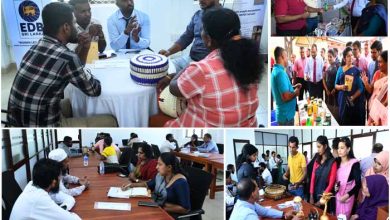A New Dawn for Sri Lanka’s Export Landscape

a meeting was held at the Sri Lanka Export Development Board (EDB) to discuss enhancing bilateral trade relations between Switzerland and Sri Lanka. The meeting was attended by H.E. Dr. Siri Walt, Ambassador of Switzerland to Sri Lanka and the Maldives, and Mr. Mangala Wijesinghe, Chairman & Chief Executive Officer of the Sri Lanka Export Development Board.
The discussions focused on expanding economic collaboration between the two countries. Mr. Wijesinghe outlined Sri Lanka’s comprehensive Export Development Plan, which aims to boost the country’s export sector. He has emphasized key strategies to be included in the plan such as expanding the product basket, increasing value addition, and reactivation of the Export Development Council of Ministers (EDCM) to identify and address challenges in the export industry.
Mr. Wijesinghe also emphasized the importance of political stability and the new government’s commitment to good governance and transparent procurement processes in bolstering investor confidence. He highlighted that consolidating related institutions under the Ministry of Industries & Entrepreneurship Development was a crucial step toward improving operational efficiency. This streamlined approach is designed to accelerate decision-making, ensuring swift implementation of policies and minimizing delays.
In expressing his gratitude to the Swiss government, Mr. Wijesinghe acknowledged Switzerland’s support in market research for selected export sectors and the implementation of the Global Textile Programme (GTEX) in Sri Lanka. This program has played a vital role in uplifting small and medium-sized textile and apparel enterprises in the country. He also recognized Switzerland’s significant role as a trading partner and identified potential areas of collaboration, particularly in knowledge-sharing, innovation, and sustainable trade practices.
H.E. Dr. Walt congratulated the Sri Lankan government for conducting peaceful elections and maintaining its commitment to the IMF process. She stressed the importance of traceability in global trade, noting that transparency and accountability are essential for building trust within supply chains. Dr. Walt also emphasized that fostering a corruption-free environment would attract more investment, particularly in Sri Lanka’s tourism sector. Further she expressed strong support for Sri Lanka’s Business Circle, acknowledging its value in promoting business development and facilitating networking opportunities. She highlighted its potential to connect Sri Lankan entrepreneurs with international counterparts, fostering knowledge exchange and investment prospects.
Furthermore, H.E. Dr. Walt announced plans for a proposed Swiss Business Delegation visit to Sri Lanka in mid-June 2025. This visit aims to strengthen business ties through dedicated forums and B2B meetings. Dr. Walt also commended Sri Lanka’s Export Development Plan, recognizing its potential to enhance export capacity, diversify market reach, and align with evolving global trade trends.
The EDB sought the Swiss Embassy’s support in organizing “Sri Lanka Expo,” scheduled to take place in June 2026, to showcase Sri Lanka’s export potential on an international platform.
Both parties concluded the meeting with a mutual commitment to continue the ongoing dialogue and collaboration, reinforcing the shared objective of strengthening economic ties and enhancing trade relations between the two countries. This meeting underscores the EDB’s ongoing efforts to elevate Sri Lanka’s presence in global trade while fostering meaningful international partnerships.






